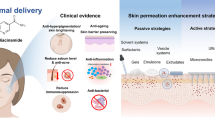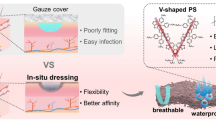Abstract
This experimental study examined the effects of curcumin-loaded iron oxide nanoparticles (CUR), photobiomodulation (PBM), and CUR + PBM treatments on mast cells (MC)s numbers and degranulation, inflammatory cells (macrophages, neutrophils), and wound strength in the last step of the diabetic wound repair process (maturation phase) in a rat model of type one diabetes mellitus (T1DM). T1DM was induced in 24 rats, and 1 month later, an excisional wound was created on each rat’s back skin. The rats were then distributed into four groups: (1) untreated diabetic control group (UDCG); (2) rats treated with CUR (CUR); (3) rats exposed to PBM (890 nm, 80 Hz, 0.2 J/cm2) (PBM); (4) rats treated with CUR plus PBM (CUR + PBM). Fifteen days after surgery, skin tissue samples were taken for biomechanical and stereological evaluations. The biomechanical factor of maximum force was observed to be considerably improved in the CUR + PBM (p = 0.000), PBM (p = 0.014), and CUR (p = 0.003) groups compared to the UDCG. CUR + PBM, PBM, and CUR groups had significantly decreased total numbers of MC compared with the UDCG (all, p = 0.001). The results were significantly better in the CUR + PBM (p = 0.000) and PBM (p = 0.003) groups than in the CUR group. Inflammatory cell counts were significantly lower in the CUR + PBM, PBM, and CUR groups than in the UDCG (all, p = 0.0001). In all evaluating methods, the usage of CUR + PBM produced better results than the use of CUR or PBM alone (almost all tests, p = 0.0001). CUR + PBM, PBM, and CUR significantly improved the repair of diabetic skin wounds in type 1 DM rats through significant decreases of MC number, degranulation, and inflammatory cells as well as a noteworthy improvement in wound strength. The impact of CUR + PBM was superior to that of either PBM or CUR alone. It is suggested that CUR + PBM could be used as a MC stabilizer for the effective treatment of some related human diseases.






Similar content being viewed by others
References
Reber LL, Sibilano R, Mukai K, Galli SJ (2015) Potential effector and immunoregulatory functions of mast cells in mucosal immunity. Mucosal Immunol 8:444–463
Beghdadi W, Madjene LC, Benhamou M, Charles N, Gautier G, Launay P, Blank U (2011) Mast cells as cellular sensors in inflammation and immunity. Front Immunol 2:37
Dong J, Chen L, Zhang Y, Jayaswal N, Mezghani I, Zhang W, Veves A (2020) Mast cells in diabetes and diabetic wound healing. Adv Ther 37(11):4519–4537. https://doi.org/10.1007/s12325-020-01499-4
Tellechea A, Leal EC, Kafanas A, Auster ME, Kuchibhotla S, Ostrovsky Y, Tecilazich F, Baltzis D, Zheng Y, Carvalho E (2016) Mast cells regulate wound healing in diabetes. Diabetes 65:2006–2019
Spampinato SF, Caruso GI, De Pasquale R, Sortino MA, Merlo S (2020) The treatment of impaired wound healing in diabetes: looking among old drugs. Pharmaceuticals 13:60
Mohanty C, Das M, Sahoo SK (2012) Emerging role of nanocarriers to increase the solubility and bioavailability of curcumin. Expert Opin Drug Deliv 9:1347–1364
Sidhu GS, Singh AK, Thaloor D, Banaudha KK, Patnaik GK, Srimal RC, Maheshwari RK (1998) Enhancement of wound healing by curcumin in animals. Wound Repair Regen 6:167–177
Akbik D, Ghadiri M, Chrzanowski W, Rohanizadeh R (2014) Curcumin as a wound healing agent. Life Sci 116:1–7
Mohanty C, Sahoo SK (2017) Curcumin and its topical formulations for wound healing applications. Drug Disc Today 22:1582–1592
Moradi A, Kheirollahkhani Y, Fatahi P, Abdollahifar M-A, Amini A, Naserzadeh P, Ashtari K, Ghoreishi SK, Chien S, Rezaei F (2019) An improvement in acute wound healing in mice by the combined application of photobiomodulation and curcumin-loaded iron particles. Lasers Med Sci 34:779–791
Naserzadeh P, Hafez AA, Abdorahim M, Abdollahifar MA, Shabani R, Peirovi H, Simchi A, Ashtari K (2018) Curcumin loading potentiates the neuroprotective efficacy of Fe3O4 magnetic nanoparticles in cerebellum cells of schizophrenic rats. Biomed Pharmacother 108:1244–1252
Oyebode O, Houreld NN, Abrahamse H (2021) Photobiomodulation in diabetic wound healing: A review of red and near-infrared wavelength applications. Cell Biochem Funct 39(5):596–612. https://doi.org/10.1002/cbf.3629
Bagheri M, Amini A, Abdollahifar MA, Ghoreishi SK, Piryaei A, Pouriran R, Chien S, Dadras S, Rezaei F, Bayat M (2018) Effects of photobiomodulation on degranulation and number of mast cells and wound strength in skin wound healing of streptozotocin-induced diabetic rats. Photomed Laser Surg 36:415–423
Kouhkheil R, Fridoni M, Abdollhifar M-A, Amini A, Bayat S, Ghoreishi SK, Chien S, Kazemi M, Bayat M (2019) Impact of photobiomodulation and condition medium on mast cell counts, degranulation, and wound strength in infected skin wound healing of diabetic rats. Photobiomodulation Photomed Laser Surg 37:706–714
Brem H, Tomic-Canic M (2007) Cellular and molecular basis of wound healing in diabetes. J Clin Investig 117:1219–1222
Mostafavinia A, Amini A, Ghorishi SK, Pouriran R, Bayat M (2016) The effects of dosage and the routes of administrations of streptozotocin and alloxan on induction rate of typel diabetes mellitus and mortality rate in rats. Lab Animal Res 32:160–165
Lodhia J, Mandarano G, Ferris N, Eu P, Cowell S (2010) Development and use of iron oxide nanoparticles (Part 1): synthesis of iron oxide nanoparticles for MRI. Biomed Imaging Intervention J 6:e12
Mahmoudi M, Hosseinkhani H, Hosseinkhani M, Boutry S, Simchi A, Journeay WS, Subramani K, Laurent S (2011) Magnetic resonance imaging tracking of stem cells in vivo using iron oxide nanoparticles as a tool for the advancement of clinical regenerative medicine. Chem Rev 111:253–280
Ahmadi H, Bayat M, Amini A, Mostafavinia A, Ebrahimpour-Malekshah R, Gazor R, Asadi R, Gachkar L, Rezaei F, Shafikhani SH, Ghoreishi SK, Chien S (2022) Impact of preconditioned diabetic stem cells and photobiomodulation on quantity and degranulation of mast cells in a delayed healing wound simulation in type one diabetic rats. Lasers Med Sci 37(3):1593–1604. https://doi.org/10.1007/s10103-021-03408-9
Babaei S, Bayat M, Nouruzian M, Bayat M (2013) Pentoxifylline improves cutaneous wound healing in streptozotocin-induced diabetic rats. Eur J Pharmacol 700:165–172
Duguay BA, Lu L, Arizmendi N, Unsworth LD, Kulka M (2020) The possible uses and challenges of nanomaterials in mast cell research. J Immunol 204:2021–2032
Gupta SC, Patchva S, Koh W, Aggarwal BB (2012) Discovery of curcumin, a component of golden spice, and its miraculous biological activities. Clin Exp Pharmacol Physiol 39:283–299
Dai X, Liu J, Zheng H, Wichmann J, Hopfner U, Sudhop S, Prein C, Shen Y, Machens H-G, Schilling AF (2017) Nano-formulated curcumin accelerates acute wound healing through Dkk-1-mediated fibroblast mobilization and MCP-1-mediated anti-inflammation. NPG Asia Materials 9:e368–e368
Wulff BC, Wilgus TA (2013) Mast cell activity in the healing wound: more than meets the eye? Exp Dermatol 22:507–510
Olivera A, Beaven MA, Metcalfe DD (2018) Mast cells signal their importance in health and disease. J Allergy Clin Immunol 142:381–393
Graham AC, Temple RM, Obar JJ (2015) Mast cells and influenza a virus: association with allergic responses and beyond. Front Immunol 6:238
Hu Y, Jin Y, Han D, Zhang G, Cao S, Xie J, Xue J, Li Y, Meng D, Fan X (2012) Mast cell-induced lung injury in mice infected with H5N1 influenza virus. J Virol 86:3347–3356
St John AL, Rathore AP, Raghavan B, Ng M-L, Abraham SN (2013) Contributions of mast cells and vasoactive products, leukotrienes and chymase, to dengue virus-induced vascular leakage. Elife 2:e00481
Amini A, Soleimani H, Rezaei F, Ghoreishi SK, Chien S, Bayat M (2021) The combined effect of photobiomodulation and curcumin on acute skin wound healing in rats. J Lasers Med Sci 12:e9. https://doi.org/10.34172/jlms.2021.09
Soleimani H, Amini A, Abdollahifar M-A, Norouzian M, Kouhkheil R, Mostafavinia A, Ghoreishi SK, Bayat S, Chien S, Bayat M (2021) Combined effects of photobiomodulation and curcumin on mast cells and wound strength in wound healing of streptozotocin-induced diabetes in rats. Lasers Med Sci 36:375–386
El-Refaie WM, Elnaggar YS, El-Massik MA, Abdallah OY (2015) Novel curcumin-loaded gel-core hyaluosomes with promising burn-wound healing potential: development, in-vitro appraisal and in-vivo studies. Int J Pharm 486:88–98
McGee GS, Davidson JM, Buckley A, Sommer A, Woodward SC, Aquino AM, Barbour R, Demetriou AA (1988) Recombinant basic fibroblast growth factor accelerates wound healing. J Surg Res 45:145–153
Yallapu MM, Jaggi M, Chauhan SC (2013) Curcumin nanomedicine: a road to cancer therapeutics. Curr Pharm Des 19:1994–2010
Montazerabadi A, Beik J, Irajirad R, Attaran N, Khaledi S, Ghaznavi H, Shakeri-Zadeh A (2019) Folate-modified and curcumin-loaded dendritic magnetite nanocarriers for the targeted thermo-chemotherapy of cancer cells. Artif Cells Nanomedicine Biotechnol 47:330–340
da Silva EZM, Jamur MC, Oliver C (2014) Mast cell function: a new vision of an old cell. J Histochem Cytochem 62:698–738
Voss M, Kotrba J, Gaffal E, Katsoulis-Dimitriou K, Dudeck A (2021) Mast cells in the skin: defenders of integrity or offenders in inflammation? Int J Mol Sci 22:4589
Funding
The present article is financially supported by “Research Department of the School of Medicine” at Shahid Beheshti University of Medical Sciences, Tehran, Iran (Grant No.:30491), (IR.SBMU.MSP.REC.1400. 675).
Author information
Authors and Affiliations
Contributions
MB wrote the manuscript. AA, HA, MM, HO, and SB performed the experiments. AA and MF added their comments. SC reviewed and edited the manuscript. AM performed the statistical methods. All the authors confirmed the manuscript.
Corresponding authors
Ethics declarations
Medical ethical approval
All procedures were approved by the IRB of Shahid Beheshti University of Medical Sciences (IR.SBMU.MSP.REC.1400. 675).
Conflict of interest
The authors declare no competing interests.
Additional information
Publisher's note
Springer Nature remains neutral with regard to jurisdictional claims in published maps and institutional affiliations.
Rights and permissions
Springer Nature or its licensor holds exclusive rights to this article under a publishing agreement with the author(s) or other rightsholder(s); author self-archiving of the accepted manuscript version of this article is solely governed by the terms of such publishing agreement and applicable law.
About this article
Cite this article
Ardeshirzadeh, A., Ahmadi, H., Mirzaei, M. et al. The combined use of photobiomodulation and curcumin-loaded iron oxide nanoparticles significantly improved wound healing in diabetic rats compared to either treatment alone. Lasers Med Sci 37, 3601–3611 (2022). https://doi.org/10.1007/s10103-022-03639-4
Received:
Accepted:
Published:
Issue Date:
DOI: https://doi.org/10.1007/s10103-022-03639-4




